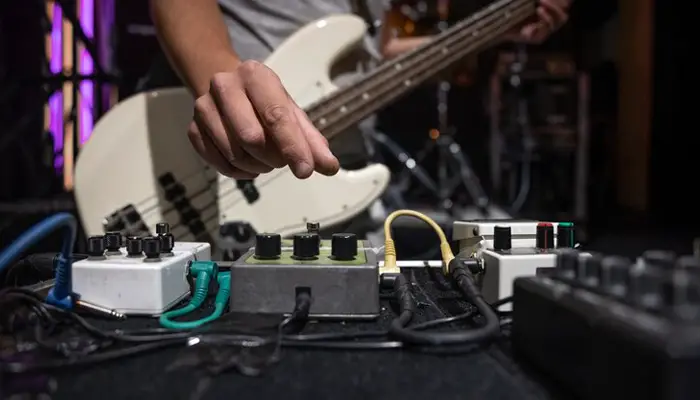
Do you want to know what is a synthesizer?
This is a question that many people ask, and it can be difficult to answer because there are so many different types of synthesizers on the market.
In this comprehensive guide, we will discuss what a synthesizer is, the different types of synthesizers available, and how to choose the right one for your needs.
We’ll also cover some basic synthesis concepts so you can understand what’s going on under the hood!
What Is a Synthesizer?
A synthesizer is an electronic musical instrument that creates sound using a variety of methods, including Additive synthesis, Subtractive Synthesis, and Frequency Modulation (FM) synthesis. Synthesizers can create a wide range of sounds, from imitations of natural sounds like acoustic instruments and drums to completely unique and otherworldly creations.
Synthesizers are used in a wide variety of musical genres, including Pop, EDM, Hip-Hop, Rock, and Classical. They can be played as standalone instruments, or they can be used to enhance the sound of other instruments in a band or orchestra.
In addition, synthesizers are often used to create sound effects for movies and TV shows. Moreover, they are commonly used in electronic products, such as in creating Basslines, Leads, and Pads.
The most popular types of synthesizers are Analog and Digital. Analog synthesizers use electronic circuits to create sound, while digital synthesizers use computer algorithms to generate sound.
What are the Different Types of Synthesizers?
The three most common types of synthesizers are Additive, Subtractive, and Frequency Modulation (FM) synthesizers.
1. Subtractive Synthesis
Subtractive synthesis is when you start out with a rich sound and remove parts to create simpler ones like what we hear from analog synths! This process uses filters that change timbre through resonant peaks at certain frequencies called formats envelope; it also utilizes which shape how loud each note sounds over time using an amplitude curve – what’s known as ADSR envelope.
In addition, subtractive synthesis can create a wide range of sounds, from imitations of natural sounds like acoustic instruments and drums to completely unique and otherworldly creations.
2. FM (Frequency Modulation) Synthesis
FM (frequency modulation) synthesis uses a carrier signal for its timbre, which is what gives you that metallic sound; then it modulates another source at different frequencies to create new tones!
This process doesn’t use filters but instead relies heavily on how fast or slow the frequency changes between two signals – this is what’s called the modulation index.
In addition, FM synthesis can create a wide range of sounds, from imitations of natural sounds like acoustic instruments and drums to completely unique and otherworldly creations.
3. Additive Synthesis
The additive synthesis starts with basic waveforms like sine waves and combines them to create new sounds, just as the name suggests! This process can be very complex but it also allows for a great deal of control over the final sound.
Moreover, additive synthesis can create a wide range of sounds, from imitations of natural sounds like acoustic instruments and drums to completely unique and otherworldly creations.
Synthesizer vs Keyboard
The main difference between a synthesizer and a keyboard is that a synthesizer can create its own sound, while a keyboard cannot. A keyboard is simply an input device that plays pre-recorded sounds.
Another difference between a synthesizer and a keyboard is that a synthesizer usually has more options for creating different sounds. For example, a synthesizer might have options for creating different types of waves, while a keyboard might only have a few basic sounds.
In general, a synthesizer is more versatile and can create a wider range of sounds than a keyboard. However, a keyboard is usually cheaper and easier to use, so it may be a better option for someone who is just starting out.
How to Use a Synthesizer?
If you want to create your own sound, you will need to use a synthesizer. To do this, you will need to connect the synthesizer to an amplifier or speaker. Then, you will need to turn on the power and select a sound.
Most synthesizers have a keyboard that you can use to play notes. You can also use the keyboard to create different sounds by holding down multiple keys at the same time. Some synthesizers also have a pitch wheel that you can use to change the pitch of the sound.
To create a sound, you will need to experiment with the different controls on the synthesizer. Each control will create a different effect on the sound. For example, the filter control can be used to change the tone of the sound.
Some synthesizers also have a built-in sequencer that you can use to create your own beats. To use the sequencer, you will need to connect the synthesizer to a computer or other device that can record and playback audio.
The best way to learn how to use a synthesizer is to experiment and have fun. There is no right or wrong way to create a sound. Just experiment with the different controls and see what sounds you can create.
How Do I Choose the Right Synthesizer?
The first thing to consider when choosing what kind of synthesizer you want is what type of sound it produces.
Then think about how much control over the timbre will be required in your music-making process – this can help narrow down what types are best suited for what needs!
Also, consider cost since some models may come at higher prices than others due to their features or brand name recognition.
Meanwhile, you can also check out How Many Octaves on a Piano.
Conclusion: What Is a Synthesizer?
There are many different types of synthesizers available on the market, and each one has its own unique sound. When choosing a synthesizer, you will need to decide what type of sound you want to create. You will also need to consider how much control you need over the timbre of the sound. Consider cost as well, since some synthesizers can be quite expensive.
Ultimately, the best way to choose the right synthesizer is to experiment and have fun. There is no right or wrong way to create a sound. Just experiment with the different controls and see what sounds you can create.
We hope you now have a better understanding of what is a synthesizer and the different types that are available on the market.
Each type has its own unique properties, so be sure to do your research before making a purchase!
Frequently Ask Questions
What is a synthesizer used for?
A synthesizer is an electronic instrument that creates sounds by generating electrical signals. Synthesizers can imitate the sound of other instruments, or they can create new, original sounds.
What is the difference between a keyboard and a synthesizer?
The main difference between a keyboard and a synthesizer is that a synthesizer can create its own sound, while a keyboard cannot. A keyboard is simply an input device that plays pre-recorded sounds. Another difference between a synthesizer and a keyboard is that a synthesizer usually has more options for creating different sounds.
Is a synthesizer the same as a piano?
No, a synthesizer is not the same as a piano. A piano is an acoustic instrument that creates sound by striking strings with hammers.
You can also check out What Is a Synth Pad and How to Use It in Music Production and How to Connect a Keyboard to FL Studio.



